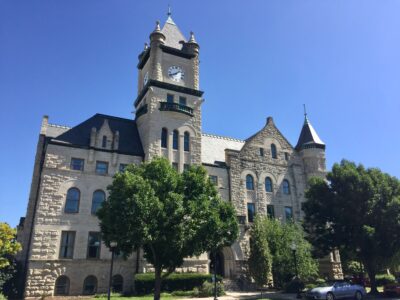Lawrence-based National Heritage Area group to relocate from Carnegie Building to Watkins Museum; it cites uncertainty about federal funds

photo by: Bremen Keasey
The Carnegie Building in downtown Lawrence, located at 200 W. Ninth St. The Freedom Frontier National Heritage Area announced it would be moving its offices out of the building and into the Watkins Museum due to cuts to federal funding.
The ability of the Freedom’s Frontier National Heritage Area to open up its interpretive displays at the Carnegie Building in downtown Lawrence in 2011 helped change the organization.
“When they opened to the public, we were no longer just an industry-facing group, but a public-facing one,” Johnny Szlauderbach, the director of communications and projects for the FFNHA, said.
Those displays at the Carnegie Building, 200 W. Ninth St., face an uncertain future. The FFNHA announced in a press release Monday that it would be relocating its offices from the Carnegie Building to the Watkins Museum of History, 1047 Massachusetts St., citing uncertainty about “the future of federal funding for National Heritage Areas across the country.”
Szlauderbach said that in the most recent proposed federal budget the funding for all National Heritage Areas has been “zeroed out” by the Trump administration. While he said similar cuts were proposed by Trump during his first term, Congress eventually changed the proposal to include funding to the NHA program. This time, Szlauderbach said the group has faced difficulty receiving previously appropriated funds, and he believes it’s more likely Congress would follow through on the proposal to totally cut its federal dollars.
National Heritage Areas are private-public programs that first started in the 1980s under President Ronald Reagan with the goal of creating economic development by promoting a region’s history. Currently, there are 62 distinct NHAs across 36 states according to the National Park Service, with those groups receiving between $150,000 and $750,000 in federal funding each year through the National Park Service, according to the NHA website.
Szlauderbach said the loss of federal funding meant the FFNHA began to enter austerity measures to be able to continue with one of its main goals of providing financial support for the over 230 museums, historical societies, and heritage sites throughout Kansas and Missouri that partner with the group.
Szlauderbach said many of the partner sites are “passion projects,” run by all-volunteer groups in rural places like one-room schoolhouses. The FFNHA can help direct funding to keep those places running if they need a new roof or need to fix an AC unit. Closing the physical space at the Carnegie Building was one way to make cuts to allow that crucial work to continue in the near term.
“Moving to the Watkins Museum allows us to continue to focus on partners’ projects,” Szlauderbach said.
Szlauderbach said the Watkins Museum and the Douglas County Historical Society have been a “strong champion” since the FFNHA’s beginning, and in some ways, moving the office to that site is “in essence, returning to (their) roots.”
In a press release, Steve Nowak, the executive director of the Watkins Museum of History, said the group was glad to welcome FFNHA to the building. He said the partnership deepens the collaborative work and “positions both organizations to better serve the public and preserve the powerful stories of our region’s past.”
Although the FFNHA is leaving the Carnegie Building for now, the city-owned building won’t sit empty. Cori Wallace, a spokesperson for the city, told the Journal-World the building has been used for community engagement efforts and by city departments as a larger meeting space for things like internal leadership programs. Additionally, Explore Lawrence has leased office space in the building since 2011.
But the public displays of FFNHA could be impacted by the group’s move. Szlauderbach said the group wants to keep them open in some capacity, but the group is not ready to announce the next steps yet. Although the relocation is not ideal, Szlauderbach felt it is a better solution for now.
“Things could be a lot worse. This change is nowhere near the worst thing in the world,” Szlauderbach said.







